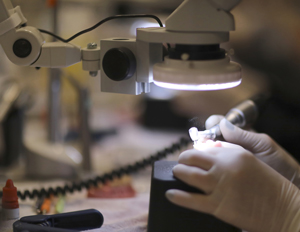
By Dr. Katherine Schrubbe, RDH, BS, MEd, PhD.
The dental lab: It’s something the dental team never wants to discuss! Upon entering the lab, they inevitably see model trimmers heaped with dental stone, lathes with scruffy rag wheels, bins of various materials, vacuum-forming machines and metal blocks holding countless stones, discs, burs and lots of dust. And, while infection control and safety team members tend to overlook the dental lab, it can pose unique challenges for the practice, which need to be addressed.
Clean and safe
According to the Centers for Disease Control and Prevention (CDC), dental prostheses, appliances and items used in their fabrication (e.g., impressions, occlusal rims and bite registrations) are potential sources for cross-contamination and should be handled in a manner that prevents exposure of DHCP, patients or the office environment to infectious agents.1,2 So, how can dental labs be kept clean and safe for dental healthcare personnel and patient care? In short, to ensure the lab is clean, only items that have been cleaned and disinfected should enter the lab.
The CDC points out that dental prostheses, impressions, orthodontic appliances and other prosthodontic materials should be thoroughly cleaned (i.e., blood and bioburden removed), disinfected with an EPA-registered hospital disinfectant with a tuberculocidal claim, and thoroughly rinsed before being handled in the in-office laboratory or sent to an off-site laboratory. And, the best time to clean and disinfect these items is as soon as possible after removal from the patient’s mouth, before drying of blood or other bioburden can occur.1 Team members should consult with the manufacturer regarding the type of disinfectant that is appropriate for use on each item, as some cleaning products may modify or alter impressions and other dental materials.
Although most dental settings have an in-office lab, many continue to rely on external labs as well; specific protocols must be in place for both to ensure safety and decreased risk of occupational exposure to microorganisms. For starters, lab should have an area designated for receiving and disinfection. Barriers should be placed on countertops, and the area should be cleaned and disinfected on a regular basis, depending on how busy the lab is.1,2 Additionally, the American Dental Association and the CDC recommend that all saliva-contaminated items be rinsed with water and disinfected before being sent to a lab, and items returning from a lab must be disinfected before being delivered to the patient.3 Lab cases and items sent to and from an external lab must include explicit written procedures for transport and receiving, as well as for returning cases that have been cleaned and disinfected for patient use.
 During patient care, prostheses often must be handled and/or taken to the lab for adjustments. In these cases, it’s advisable for dental professionals to immediately rinse each item with water after taking it from the patient. With appropriate personal protective equipment (PPE) in place, items can be placed in a beaker or zip-lock baggie containing an ultrasonic detergent; the entire unit should then be placed in an ultrasonic machine for cleaning and disinfection. If there is heavy debris on an item, it may require some initial scrubbing prior to ultrasonic cleaning. After disinfection and any necessary lab work, the item must be thoroughly rinsed and returned to the patient in a mouth-rinse solution, free from chemicals.2
During patient care, prostheses often must be handled and/or taken to the lab for adjustments. In these cases, it’s advisable for dental professionals to immediately rinse each item with water after taking it from the patient. With appropriate personal protective equipment (PPE) in place, items can be placed in a beaker or zip-lock baggie containing an ultrasonic detergent; the entire unit should then be placed in an ultrasonic machine for cleaning and disinfection. If there is heavy debris on an item, it may require some initial scrubbing prior to ultrasonic cleaning. After disinfection and any necessary lab work, the item must be thoroughly rinsed and returned to the patient in a mouth-rinse solution, free from chemicals.2
Impressions must be thoroughly rinsed with water; then, depending on the impression material and what disinfectant is compatible with that material, the impression can be immersed or sprayed with disinfectant. According to researcher C.H. Miller, it’s preferable to immerse items with an EPA-registered disinfectant, as spraying disinfectants releases chemicals into the air and does not ensure constant contact of the disinfectant with all surfaces of the impression.2,3
Disinfecting lab equipment
A lot of blasting, polishing and grinding takes place in dental labs. Again, to keep equipment as clean as possible and avoid cross-contaminating patients, only clean items must be brought into the lab. For instance, the lathe can be a dangerous machine, as it has whirling wheels, stones and bands, which generate aerosols, spatter and projectiles.2 Along with ensuring that machine guards (e.g., a plexiglass shield) are in place and utilized, the same OSHA standards for use with PPE, cleaning, disinfecting and barrier protection apply to the dental healthcare personnel working in the lab. To ensure the lathe is not the culprit of cross-contamination, a unit-dosed system should be used. Fresh polishing compounds in unit doses, sterilized or disposable rag wheels and disposable pan liners all should be available.2,3 Miller recommends that the lathe unit be disinfected twice a day.2 Also, team members should never have food or drink on hand or apply cosmetics in the lab, and refrigerators should only store medical and dental materials.3,4
Occupational exposure and PPE
Team members must remember that anything coming from a patient’s mouth and entering the lab is contaminated with saliva, bacteria and possibly blood. The CDC states that the transfer of oral microorganisms into and onto impressions has been documented, and the movement of these organisms onto dental casts has also been demonstrated.1 Incorrect handling of contaminated impressions, prostheses or appliances, therefore, can lead to the transmission of microorganisms, so PPE should be worn until disinfection is completed.1 Dental lab technicians and other dental healthcare personnel working in the lab are considered at risk for occupational exposure and, as such, must comply with OSHA standards for safety and protection.
PPE must include protective eyewear or face protection with impact resistance to guard against splashes, flying projectiles and chemicals. Staff pouring chemicals without the use of proper goggles are violating OSHA standards if the safety data sheet (SDS) specifically requires the use of eye protection.4,5,6 Also, eyewear needs to be rated by an agency, such as the American National Standards Institute (ANSI). Otherwise, it does not meet OSHA’s requirements.7
Gloves must be worn when working in the lab any time a team member is exposed to blood or other potentially infectious materials, and if chemicals are involved, team members must have chemical resistant utility-type gloves.4,6 Lab coats must be worn to protect workers’ skin and undergarment clothing from splashes, infectious agents and chemicals. And, with all of the dust and exposure to hazardous materials, respiratory protection is vital to lab safety. As such, appropriate masks and respirators are required for this type of exposure.
For instance, crystalline silica has been recently associated with harmful exposures in dental labs. Silica is commonly found in lab products like porcelain, pumice and stone. In response, OSHA introduced the Respirable Silica Standard, which went into effect for all dental labs on June 23, 2018.7,8 OSHA has lowered the Permissible Exposure Level (PEL) for silica by cutting it in half. Under this standard, employers must perform air sampling to determine whether administrative and engineering controls, such as dust collection, are adequate to protect employees.7
While most dental healthcare personnel are focused on patient care and the risk exposure associated with clinical settings, risks and exposure in the dental lab should not be forgotten. All dental settings must ensure that dental healthcare personnel working in the lab are safe for the short – and the long – term. Training dental healthcare personnel on lab safety is critical, and it’s required by OSHA.4,6 Management teams can be role models when they set high standards and foster a culture of safety in the dental setting, including safety in the dental lab.
References
- Centers for Disease Control and Prevention. Guidelines for Infection Control in Dental Health-Care Settings – 2003. MMWR 2003;52 (No. RR-17): 33-34.
- Miller CH, Palenik CJ. Infection Control and Management of Hazardous Materials for the Dental Team. 5th ed. St. Louis: Mosby Elsevier; 2013;185.
- Organization for Safety Asepsis and Prevention. OSHA and CDC Guidelines Interact Training System. Atlanta: OSAP; 2017.
- US Department of Labor. Occupational Safety and Health Administration. Bloodborne Pathogens Standard; 1910:1030. Available at https://www.osha.gov/pls/oshaweb/owadisp.show_document?p_id=10051&p_table=STANDARDS. Accessed March 19, 2019.
- Daw K, Scungio D. Modern Dental Network. The most common OSHA violations in the dental lab. October 23, 2018. Available at http://www.dentalproductsreport.com/lab/article/most-common-osha-violations-dental-lab. Accessed March 17, 2019.
- US Department of Labor. Hazard Communication. Available at: ttps://www.osha.gov/dsg/hazcom/. Accessed March 19, 2019.
- Mott, K. Modern Dental Network. 5 surefire ways to get an OSHA inspection in your dental lab. Available at http://www.dentalproductsreport.com/lab/article/5-surefire-ways-get-osha-inspection-your-dental-lab?page=0,1. Accessed March 17, 2019.
- US Department of Labor. Silica, Crystalline. Available at https://www.osha.gov/dsg/topics/silicacrystalline/. Accessed March 19, 2019.
Editor’s note: Dr. Katherine Schrubbe, RDH, BS, M.Ed, PhD, is an independent compliance consultant with expertise in OSHA, dental infection control, quality assurance and risk management. She is an invited speaker for continuing education and training programs for local and national dental organizations, schools of dentistry and private dental groups. She has held positions in corporate as well as academic dentistry and continues to contribute to the scientific literature. Dr. Schrubbe can be reached at [email protected].

